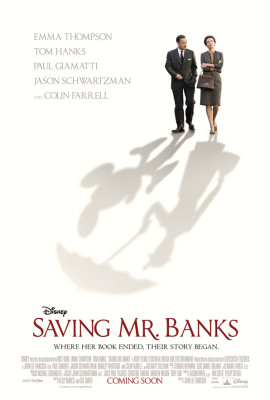Film Reviews

Saving Mr. Banks
Genre: Drama
Director: John Lee Hancock
Cast: Emma Thompson, Tom Hanks, Paul Giamatti, Jason Schwartzman, Bradley Whitford, Colin Farrell, Ruth Wilson, B.J. Novak, Rachel Griffiths, Kathy Baker
MPAA-Rating: PG-13
Release Date: December 12th 2013
In a year of serious and powerful cinematic fare, website like this Saving Mr. Banks is a wonderfully idealistic concoction. Loosely based on the true story of how the 1964 classic Mary Poppins arrived on the big screen, this production focuses on the relationship between curmudgeonly author P.L. Travers (Emma Thompson) and the naturally-charismatic Walt Disney (Tom Hanks), who needed to buy the rights to Travers’ children’s book before he could make his film.
As the story begins, Travers has long since decided that Disney– who she doesn’t know and couldn’t trust– should not have those rights. Disney had consistently tried to acquire them for over twenty years to no avail. Early on in the film, though, it looks like she could lose her house if she doesn’t get more money so off she flies to California to examine the possibility of selling her beloved book.
She doesn’t hear anything she likes. In fact, she despises everything about her trip to California including the state itself, her talkative driver (Paul Giamatti) and Mr. Disney, who packs her hotel room with so many stuffed animals and treats that it looks like a five-year old’s birthday party. Excess may be the name of the game for Disney but Travers prefers a more subtle and thoughtful discussion. She doesn’t get it.
Soon, she’s walking through the potential script line by line questioning nearly everything about it. She doesn’t want animation in the film. Or Dick Van Dyke. Or the color red. At the same time as we watch Disney try to appease her, we see why she loves her characters so much through flashbacks showcasing her loving but careless father (Colin Farrell) and unassuming mother (Ruth Wilson).
Some have criticized this film for its white-washed portrayal of the relationship between Disney and Travers. It is true that this is a Disney production and the film follows a tried-and-true template of slowly showing Travers compromise and work alongside— instead of against— the screenwriter and the songwriters who will be bringing her characters to light. I can understand the criticism but it’s hard not to appreciate the story as it is.
Thompson, for one, does a stellar job bringing this uptight but emotionally-haunted personality to life. It’s hard not to enjoy her steal every scene she’s in especially because the story takes knowing pains to show why Mary Poppins was so important to her. Poppins, like Mickey Mouse was to Disney, was not simply a character in a story. She was a part of Travers and because of that, the author kept fighting to keep that character true, believing that Poppins did not arrive at the Banks household to save the children– as Disney suggests–but to save their father (hence the movie’s title).
With a lot of Disney films, audiences have to suspend their disbelief and when you do that here (forgetting about all of the real-life sour feelings Travers felt about the film), the movie works like a magical and powerful portrait of a woman coming to terms with her painful past. Watching the character slowly but surely embrace aspects of the film (a special singing of “Let’s Go Fly a Kite” is especially spectacular), it’s hard not to root for this story and to imagine that it was more true than it is.
I can appreciate the criticisms leveled here but walking out of the theater after seeing this movie, I felt excited about films again and wonderfully engrossed by this well-told story. It’s an enchanting magical motion picture.
It might not be the whole truth but maybe a bit of cinematic magic is good every once in a while, especially when so many films this year have explored so many painful truths already.
Review by: John Hanlon












